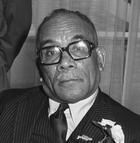Jan Viktor Kamassan Kaisiëpo Msn (1948-2010 ) was named after Jean Victor de Bruijn. “Msn” means “Manseren”, a qualification for the highest Papuan “caste”.
The Kaisiëpo family are from Biak, a seagoing and fighting nation. In the 1930s an independence movement, the Koreri movement, emerged in Biak.
 After the Second World War, the Dutch started training Papuans for administrative positions.
After the Second World War, the Dutch started training Papuans for administrative positions.
Jan Viktor’s father, Marcus Kaisiëpo, was among them.
A gradual transfer of administration and government to the Papuans was envisaged.
The “New-Guinea Council”, with Marcus Kaisiëpo and Nicolaas Jouwe as prominent Papua members, was a stage in this process; its final goal was independence.
On 1 December 1961 the Council inaugurated a flag for Papua New Guinea: the Morning Star.
 During the Second World War the Papuans had realized that they had no affinity with the Dutch, nor with the Japanese or any other Asiatic people.
During the Second World War the Papuans had realized that they had no affinity with the Dutch, nor with the Japanese or any other Asiatic people.
Beginning in 1948, Nicolaas Jouwe and Marcus Kaisiëpo took part in the conferences of the South Pacific Commission, a result of the Canberra Agreement, an international collaborative association of the peoples of the non-self-governing territories in the South Pacific.
Even today, the Kaisiëpo family propagates independence for the Papuans within a pan-Melanesian federation.
 Independence never came, as New Guinea became the plaything of national and international politics.
Independence never came, as New Guinea became the plaything of national and international politics.
On 15 August 1962, under pressure from the US government, the New York Agreement was signed.
Under the terms of the agreement an interim UN administration was to gradually transfer power to Indonesia.
That same year, 1962, a great exodus of Dutch settlers in New Guinea started.
Feeling unsafe under Indonesian rule, about a hundred Papua families joined them.
 The Kaisiëpo family, too, was, as Jan Viktor put it, “deported” to the Netherlands, a terribly cold country. They experienced the icy winter of 1963 and the total indifference of the Dutch towards Papuan aspirations.
The Kaisiëpo family, too, was, as Jan Viktor put it, “deported” to the Netherlands, a terribly cold country. They experienced the icy winter of 1963 and the total indifference of the Dutch towards Papuan aspirations.
In 1965, Marcus Kaisiëpo appointed himself President of Papua. Nicolaas Jouwe did so, too, and in 1971 they were joined by Seth Rumkorem. Three presidents of a non-existing nation awaiting their turn in the Netherlands.
In 1969 a UN-organized referendum on self-government was held among the Papuans. The referendum was a complete farce.
Papua officially became a province of Indonesia.
Deception and a great deal of incomprehension reigned in West Papua.
Jan Viktor Kaisiëpo Msn, Een perspectief voor Papoea (2011); J.V. Kaisiëpo archive at the IISH, Stichting Hulp Papoea's in Nood arcjhive at the IISH(HAPIN)
